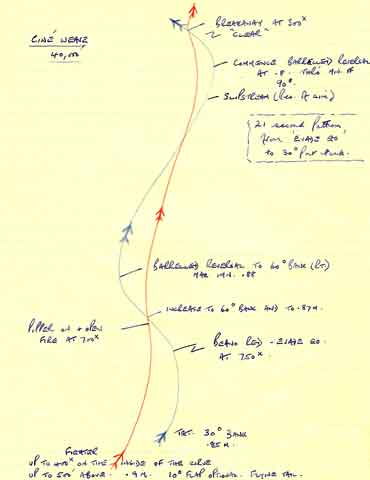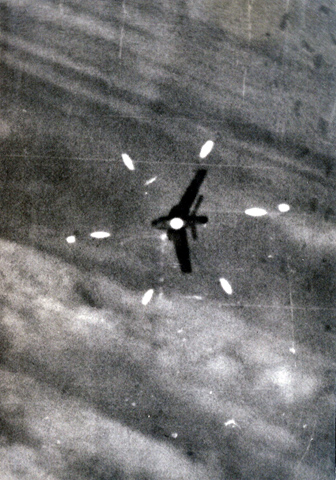|

The above diagram was written by Paddy Hine when a Flight Commander on 93 Sqn and
Brian Butterworth kept Paddy's handwritten notes.
 In order to improve tracking skills, usually two aircraft would alternately fly as target and attacking aircraft. The target aircraft flew a gentle rolling and diving/climbing pattern whilst the attacker took cine film showing his ability to keep the aiming "pipper" on the target cockpit. Cine assessors were able to score the cine gun camera film to provide a mark for the attacking pilot. This exercise was held at various heights. It became more difficult to keep smooth tracking at higher altitudes. In order to improve tracking skills, usually two aircraft would alternately fly as target and attacking aircraft. The target aircraft flew a gentle rolling and diving/climbing pattern whilst the attacker took cine film showing his ability to keep the aiming "pipper" on the target cockpit. Cine assessors were able to score the cine gun camera film to provide a mark for the attacking pilot. This exercise was held at various heights. It became more difficult to keep smooth tracking at higher altitudes.
THE TARGET
 This brief is for two Hunter F.6's flying at 40,000 feet. The blue track is the target Hunter and the red track is for the attacking fighter that is being assessed. This brief is for two Hunter F.6's flying at 40,000 feet. The blue track is the target Hunter and the red track is for the attacking fighter that is being assessed.
 The target Hunter starts at 0.85M at 40,000 ft and in a 30° banked turn to port. When the fighter (in this example using the callsign "Beano Red" for the pair) estimates that he is 750 yards behind the target he calls "Beano Red - Evade GO". The target Hunter starts at 0.85M at 40,000 ft and in a 30° banked turn to port. When the fighter (in this example using the callsign "Beano Red" for the pair) estimates that he is 750 yards behind the target he calls "Beano Red - Evade GO".
 The target then increases his bank to 60° and speeds up to 0.87M. The target next reverses his bank in a smooth barrel roll to 60° starboard holding his speed to a maximum of 0.88M. The target then increases his bank to 60° and speeds up to 0.87M. The target next reverses his bank in a smooth barrel roll to 60° starboard holding his speed to a maximum of 0.88M.
 Finally the target commences a barrel reversal to port at 0.8M through a minimum of 90° back to a 30° port bank. This manoeuvre should take 21 seconds from calling "Evade GO" until the target arrives back at 30° port bank. Finally the target commences a barrel reversal to port at 0.8M through a minimum of 90° back to a 30° port bank. This manoeuvre should take 21 seconds from calling "Evade GO" until the target arrives back at 30° port bank.
THE FIGHTER
 The fighter positions himself behind the target 400 yards on the inside of the target's steady 30° bank turn and 500 feet above at a speed of 0.9M. The Fighter is allowed to have 10° of flap selected, as some find the Hunter handled more smoothly at high altitudes with a little flap, and the flying tail engaged. The fighter positions himself behind the target 400 yards on the inside of the target's steady 30° bank turn and 500 feet above at a speed of 0.9M. The Fighter is allowed to have 10° of flap selected, as some find the Hunter handled more smoothly at high altitudes with a little flap, and the flying tail engaged.
 When the fighter closed to 750 yards on the target he called "Beano Red - Evade GO" He then had to have his gunsight pipper on the target Hunter's cockpit canopy and open fire with the cine gun camera at 700 yards. When the fighter closed to 750 yards on the target he called "Beano Red - Evade GO" He then had to have his gunsight pipper on the target Hunter's cockpit canopy and open fire with the cine gun camera at 700 yards.

Example of what the gunsight pipper looks like when tracking. In this case it was Bill Maish tracking a Danish F-84F and not a Hunter.
 The fighter must track the target throughout the weaving manoeuvre as he closed with the target Hunter. At a minimum of 300 yards he had to break away and call "Beano Red Clear." The fighter must track the target throughout the weaving manoeuvre as he closed with the target Hunter. At a minimum of 300 yards he had to break away and call "Beano Red Clear."
 Note the point in the diagram during the final turn reversal when the Fighter was likely to fly through the slipstream of the Target - extra care had to be taken with the tracking at that stage. Note the point in the diagram during the final turn reversal when the Fighter was likely to fly through the slipstream of the Target - extra care had to be taken with the tracking at that stage.
 The PAIs usually assessed the resulting films and each frame was scored to give a total competition score which contributed to the Duncan Trophy squadron scores. At first the Duncan Trophy was awarded purely on live gunnery scores - counted by holes in the flag. Very honest but the target flag was always towed in a straight line. It was felt that skill at tracking a manoeuvring target was more realistic. So the Cine Weave was introduced. The PAIs usually assessed the resulting films and each frame was scored to give a total competition score which contributed to the Duncan Trophy squadron scores. At first the Duncan Trophy was awarded purely on live gunnery scores - counted by holes in the flag. Very honest but the target flag was always towed in a straight line. It was felt that skill at tracking a manoeuvring target was more realistic. So the Cine Weave was introduced.
 Inevitably, once it became a competition, the squadrons would work at maximising the scores without actually cheating. A few senior pilots were selected on each squadron to fly the Target aircraft. They became skilled at flying the pattern smoothly and consistently so that the Fighter knew what to expect. Inevitably, once it became a competition, the squadrons would work at maximising the scores without actually cheating. A few senior pilots were selected on each squadron to fly the Target aircraft. They became skilled at flying the pattern smoothly and consistently so that the Fighter knew what to expect.
(Thanks to Chris Stone for being the Technical Advisor for this series.)
|







